

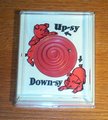
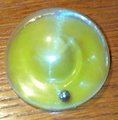 The emphasis here is on
steady hands, perseverance, and lots of patience rather than logical analysis.
In his seminal book Puzzles Old and New published in 1893, Angelo John Lewis,
writing under the pen name
"Professor Louis Hoffmann" described the class of dexterity puzzles as those
"which do not depend upon any secret, or intellectual process, but upon some knack,
only to be obtained by repeated persistent
effort of the 'try and try again' kind on the part of the operator."
(A definition one could argue which applies equally well to many video games of recent years!)
Some collectors of mechanical puzzles shun the dexterity category.
Dexterity puzzles are covered in Chapter I of Hoffmann's book, and the first example listed, No. I,
is called the "Pick-Me-Up" puzzle.
It is identical in principle to the example shown here which is called "Upsy-Downsy."
One must maneuver the ball up the spiral ramp to the detent at the pinnacle.
According to James Dalgety,
the Pick-Me-Up design is a contender for the title of World's Oldest Puzzle.
An artifact resembling this design was found in the ruins of the ancient Indus Valley city of Mohenjo-Daro and dates to
around 2500 B.C.
The emphasis here is on
steady hands, perseverance, and lots of patience rather than logical analysis.
In his seminal book Puzzles Old and New published in 1893, Angelo John Lewis,
writing under the pen name
"Professor Louis Hoffmann" described the class of dexterity puzzles as those
"which do not depend upon any secret, or intellectual process, but upon some knack,
only to be obtained by repeated persistent
effort of the 'try and try again' kind on the part of the operator."
(A definition one could argue which applies equally well to many video games of recent years!)
Some collectors of mechanical puzzles shun the dexterity category.
Dexterity puzzles are covered in Chapter I of Hoffmann's book, and the first example listed, No. I,
is called the "Pick-Me-Up" puzzle.
It is identical in principle to the example shown here which is called "Upsy-Downsy."
One must maneuver the ball up the spiral ramp to the detent at the pinnacle.
According to James Dalgety,
the Pick-Me-Up design is a contender for the title of World's Oldest Puzzle.
An artifact resembling this design was found in the ruins of the ancient Indus Valley city of Mohenjo-Daro and dates to
around 2500 B.C.
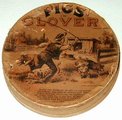
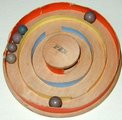
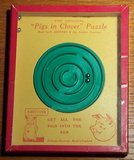 One of the best-known dexterity puzzles is Pigs in Clover, in which you are to get all the "pigs" (balls)
simultaneously into the "pig pen" at the center of the maze.
That puzzle caused a craze around 1889, and
appeared in political cartoons of the time.
Pictured are an original Pigs in Clover at left, a Journet version at right, and a version by Milton Bradley below.
One of the best-known dexterity puzzles is Pigs in Clover, in which you are to get all the "pigs" (balls)
simultaneously into the "pig pen" at the center of the maze.
That puzzle caused a craze around 1889, and
appeared in political cartoons of the time.
Pictured are an original Pigs in Clover at left, a Journet version at right, and a version by Milton Bradley below.
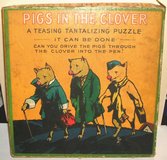
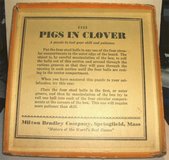
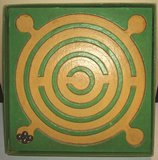
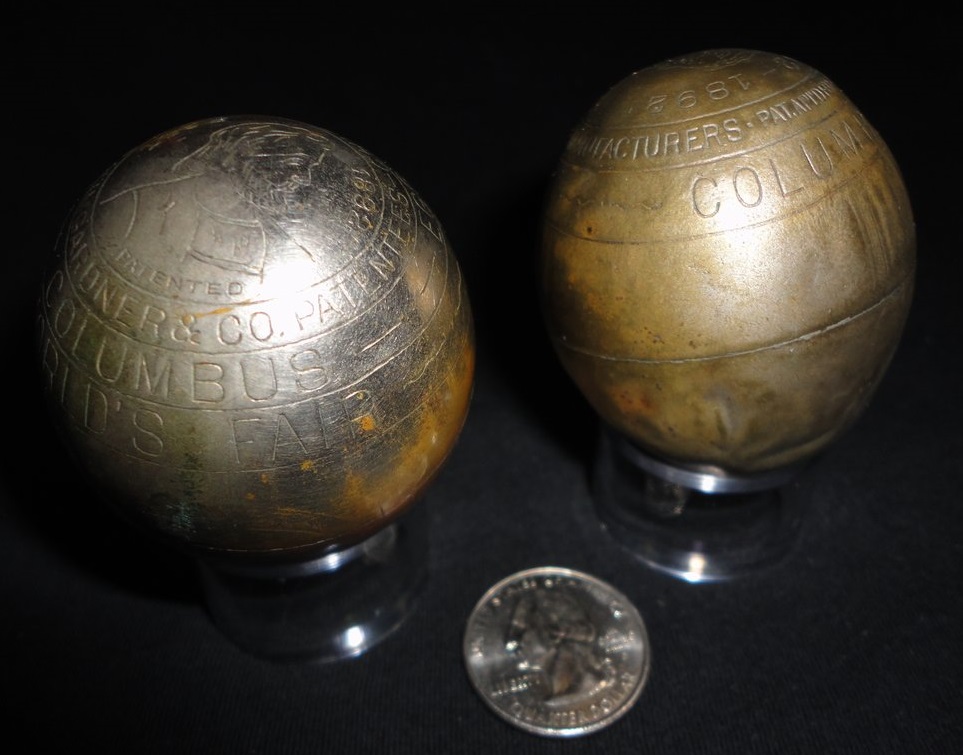 This is a pair of Columbus Egg Puzzles from the 1492-1892 Columbian Exposition and Worlds Fair.
Both are a bit dinged and blemished, but both are intact and functional.
The U.S. Patent Office devotes an entire sub-class
to "Balancing Ovoids"
(
ccl/273/154).
The theme was especially popular around the time of the 1892 Fair,
celebrating the 100th anniversary of the discovery
of America by Christopher Columbus.
For examples, see
U.S. Patent
496716 - Benitez 1893
; also
467384 - Schulze 1892; also
459233 - Woodbridge 1891 (which doesn't look like it would actually work),
and
1235306 - Fredrick 1917.
This is a pair of Columbus Egg Puzzles from the 1492-1892 Columbian Exposition and Worlds Fair.
Both are a bit dinged and blemished, but both are intact and functional.
The U.S. Patent Office devotes an entire sub-class
to "Balancing Ovoids"
(
ccl/273/154).
The theme was especially popular around the time of the 1892 Fair,
celebrating the 100th anniversary of the discovery
of America by Christopher Columbus.
For examples, see
U.S. Patent
496716 - Benitez 1893
; also
467384 - Schulze 1892; also
459233 - Woodbridge 1891 (which doesn't look like it would actually work),
and
1235306 - Fredrick 1917.
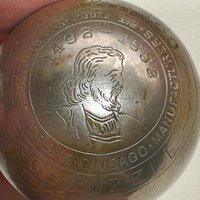 The inscriptions on one egg occur in four concentric circles on the wide end,
starting with a portrait of Columbus with the dates 1492 and 1892, and the word "patented."
I couldn't get my camera to focus on the surface inscriptions, so I saved this shot of someone else's.
The next ring contains the words "Chicago - P.M. Baumgardner & Co. Patentees."
Then "Columbus Egg Puzzle" and finally "World's Fair Souvenir."
Since mine indicates that the egg is patented, while the egg in the photo lacks the word under the portrait,
and says "Pat Apld For" after Baumgardner, there must be various versions.
The inscriptions on one egg occur in four concentric circles on the wide end,
starting with a portrait of Columbus with the dates 1492 and 1892, and the word "patented."
I couldn't get my camera to focus on the surface inscriptions, so I saved this shot of someone else's.
The next ring contains the words "Chicago - P.M. Baumgardner & Co. Patentees."
Then "Columbus Egg Puzzle" and finally "World's Fair Souvenir."
Since mine indicates that the egg is patented, while the egg in the photo lacks the word under the portrait,
and says "Pat Apld For" after Baumgardner, there must be various versions.
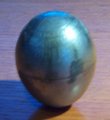 The solutions to
balancing ovoid puzzles usually depend on finding a way to take advantage of an internal mechanism,
and will require some motion trick.
You'll note that my photo, though blurry, shows the egg standing on its small end - yes, I solved it!
The solutions to
balancing ovoid puzzles usually depend on finding a way to take advantage of an internal mechanism,
and will require some motion trick.
You'll note that my photo, though blurry, shows the egg standing on its small end - yes, I solved it!
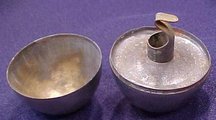 I have seen several of these come up for sale now and then, and often the seller does not realize the purpose of the
puzzle and has attempted to open it!
Please, folks, these are not meant to be prised open!
The Columbus Egg has sold for well over $100 - even this broken one went for over $150.
I saved this photo of the inside.
I have seen several of these come up for sale now and then, and often the seller does not realize the purpose of the
puzzle and has attempted to open it!
Please, folks, these are not meant to be prised open!
The Columbus Egg has sold for well over $100 - even this broken one went for over $150.
I saved this photo of the inside.
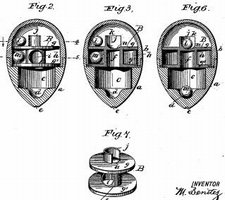 Compare this to the illustration from Benitez' patent.
The internal setup looks simplified to a single platform rather than two, but still employs the central ramp
and shaft.
Compare this to the illustration from Benitez' patent.
The internal setup looks simplified to a single platform rather than two, but still employs the central ramp
and shaft.
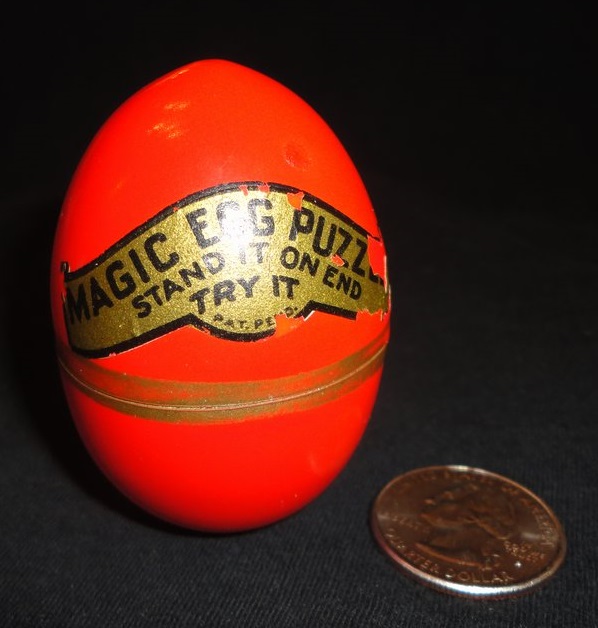 A vintage red Magic Egg Puzzle - a red celluloid (or plastic?) egg
A vintage red Magic Egg Puzzle - a red celluloid (or plastic?) egg
I was contacted by fellow collector John Davenport, who happens to own an example of this egg puzzle having a transparent top half. Presumably this version was given to store owners in order that they could demonstrate the puzzle. John kindly supplied the photos below and I include them with his permission.
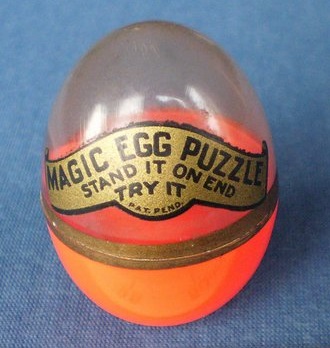
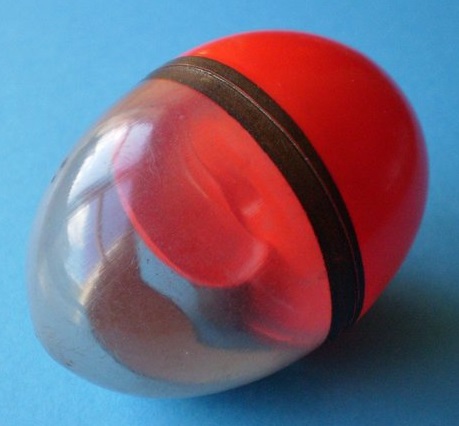
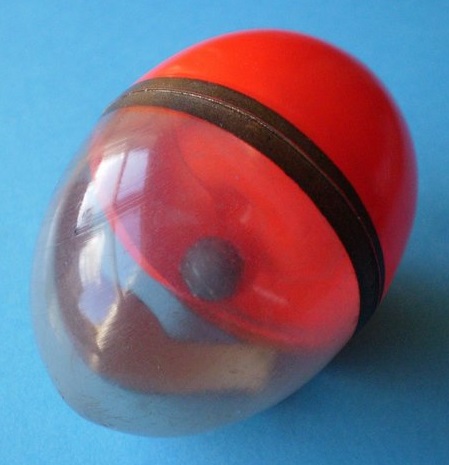
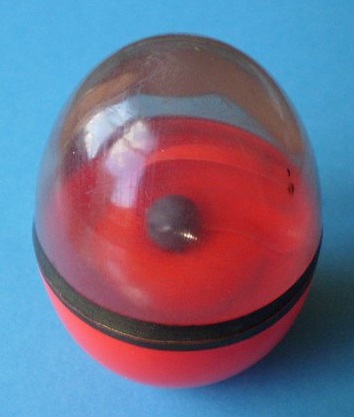
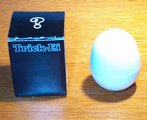 Trick-Ei (Egg) from Pussycat - the object is to balance the egg on its small end |
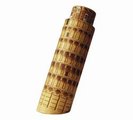 The Tower of Pisa, from Bits and Pieces. Unless you find the secret, the tower falls. |
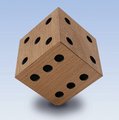 Balance the die on its corner. |
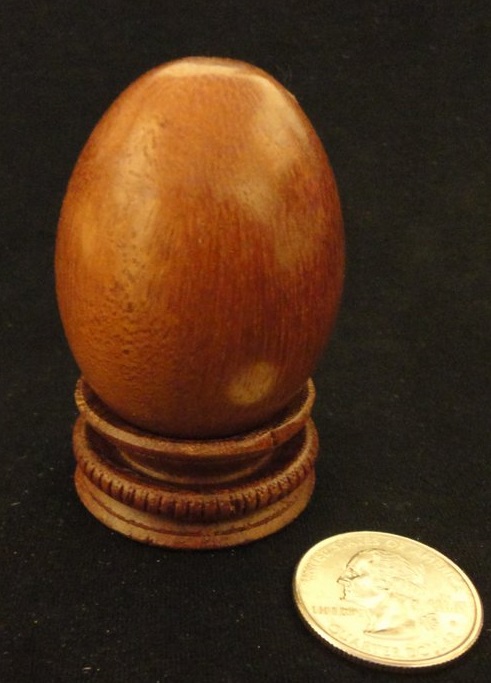
Ze Balancing Egg - designed, made, and exchanged at IPP35 by Stephen Chin |
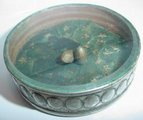 Another vintage souvenir of the 1492 - 1893 Columbian Exposition, this metal container has a glass top and contains two small metallic eggs. There are evidently magnets underneath the paper bottom of the container, which is a dark blue color printed with stars. There is no indication of the objective but it probably has to do with balancing the ovoids on their ends. |
|
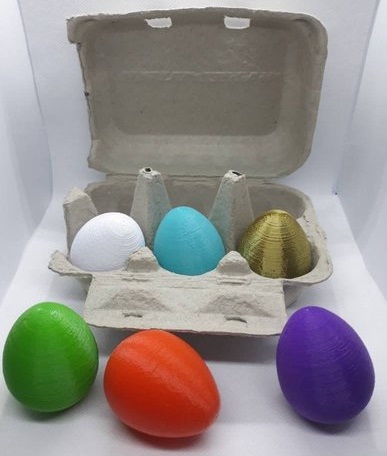
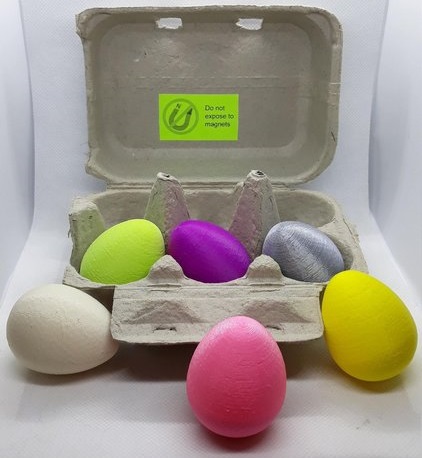
Unstable Eggs series 1 and 2 - Coremods |
||
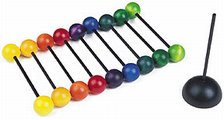
 "Balance several nails on the head of another" appears in many forms.
All rely on the head's flange.
"Balance several nails on the head of another" appears in many forms.
All rely on the head's flange.
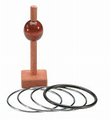 Orb |
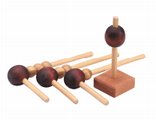 Sandpiper |
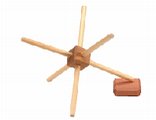 Urchin |
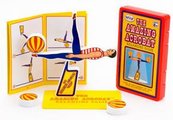 The Amazing Acrobat by Toysmith is a nicely produced dexterity challenge set.
A gift from Brett. Thanks!
The Amazing Acrobat by Toysmith is a nicely produced dexterity challenge set.
A gift from Brett. Thanks!
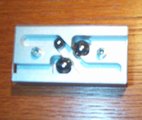 "r2d2" by "Roger" |
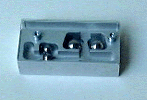 "Alles Roger" by "Roger" |
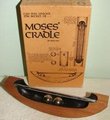 Moses' Cradle - Skor Mor Get one ball in each end. This is a very nice, hefty version. See also Journet's "Spoophem," Thinkfun's "All Uphill," and the Adams Dipsy Ball. |
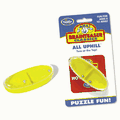 All Uphill - Thinkfun |
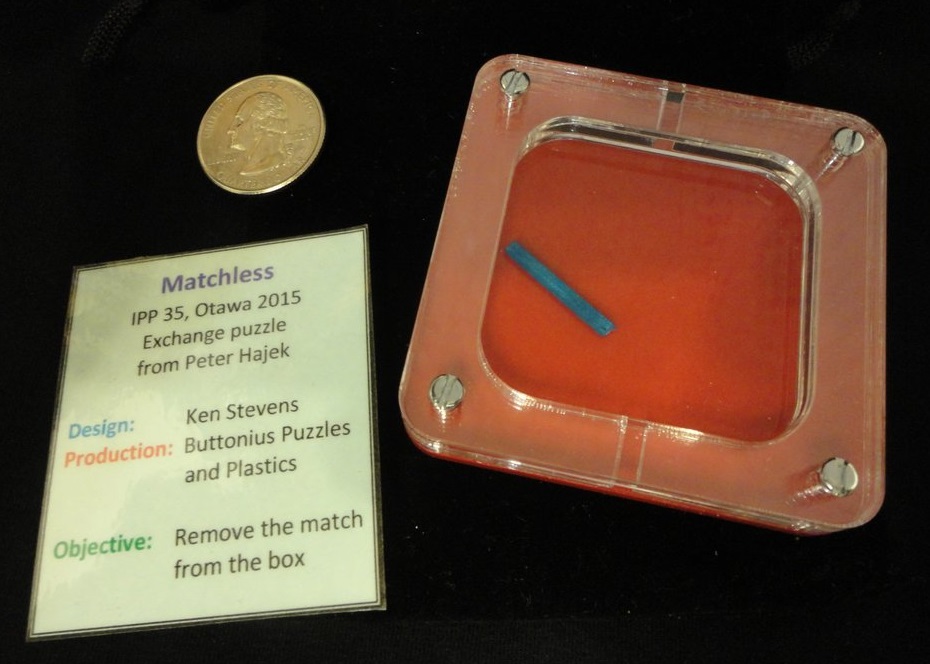
Matchless - designed by Ken Stevens made by Buttonius exchanged at IPP35 by Peter Hajek. Remove the match from the case via either small passage in the rim. |
|||
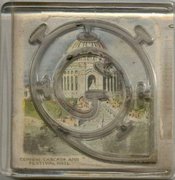
This is the Up-to-You puzzle from the 1904 Louisiana Purchase Exposition. It is a glass slab into the back of which a spiral track with eight pockets has been molded. The back is sealed with a cardboard square depicting the Central Cascade and Festival Hall of the Exposition. There are eight small ball bearings trapped in the track and the goal is to maneuver one into each pocket simultaneously. It's in great shape for something over 100 years old, and it still works - all the balls roll freely (and quite quickly I might add). There are many interesting websites devoted to the 1904 Expo. |
|
Evidently there were other designs produced using the same glass slab - I saw the Burro below but I don't have it. 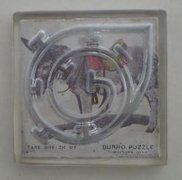
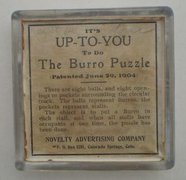
|
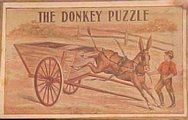
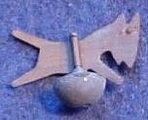
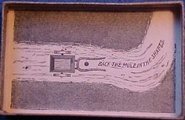 Shake the box to properly position the obstinate donkey in front of the cart.
Shake the box to properly position the obstinate donkey in front of the cart.
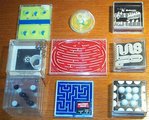 An assortment of inexpensive plastic dexterity puzzles. |
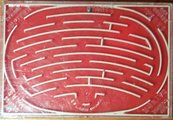
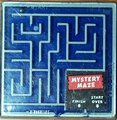 Two rolling-ball mazes from the Harmonic Reed Corp. of Conshohocken, PA - Splashdown, and the Mystery Maze, which has a permanent cover over one corner of the maze. Don't peel off the sticker! |
 Upsy Downsy Maneuver the ball up the spiral ramp to the detent at the pinnacle. |
||||
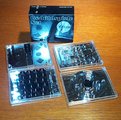 German Pussycat set |
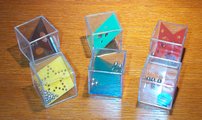 There are many different dexterity puzzles in small transparent plastic cubes. |
 Beehive - Smethport 1978 (Smethport is responsible for the well-known "Wooly Willy" toy of 1955 - paint an iron-filing beard on a face using a magnetic wand.) |
||||
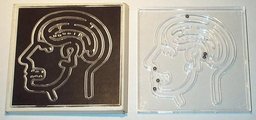 This is "The Brain" from a German company. Reiss released the same puzzle (their number 350) in a larger size and called it "Brainchild." |
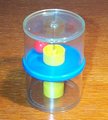
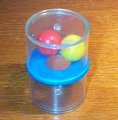 Two puzzles from Nasta (circa 1990) - "Trap 0" - move the ball to the other side of the partition. In the other, get one ball on each side of the partition. |

 Drop Out and Outer Limits by Mag-Nif In Drop-Out, navigate the ball across a maze avoiding pitfalls. In Outer Limits, get one ball to each of the four corners. |
||||
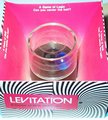
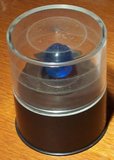 Mag-Nif Levitation 1971 #238-200 Get the ball onto the center of the pedestal. Yes, I solved it! |
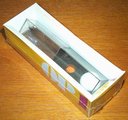
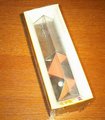

 Mag-Nif Op-1 1974 #261-200 |
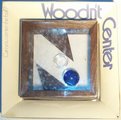 Mag-Nif Woodn't Center 1974 #409-350 Get the ball onto the pedestal. Will the two loose wooden triangles help? |
||||
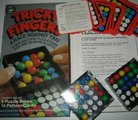 Tricky Fingers Two trays for competition, each containing colored balls and with a grid of holes in the bottom. By pushing the balls with your fingers via the holes, arrange them into various specified patterns. |
 The Original Spot Game - Skor Mor. Cover a spot with five disks. Combines the puzzle of how to arrange the disks to accomplish that, with the dexterity feat of dropping them in exactly the right places. |
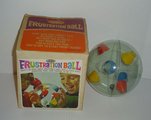 The Frustration Ball by Remco is a fairly well-known collectible. A series of cups are affixed facing inwards within a hollow transparent sphere. Tilt the sphere in an effort to transfer a ball bearing inside from cup to cup. Very frustrating - hence the name. Note to self - try not to hurl it in a fit - remember, it's a collectible! |
||||
 Babe the Pig Universal Studios movie tie-in Get five sheep in the pasture facing the right way, and close the gate. |
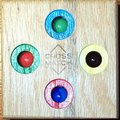 Cross Match Get the matching color marbles showing through each of the colored windows. There are four windows on each side, colored blue, yellow, red, and green. On the reverse side the window colors are switched N-S and E-W. There are six marbles: white, red, black, green, yellow, and blue. |
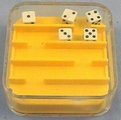 Es-Kapade Dice |
||||
 Adco No. 365 |
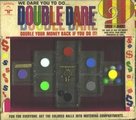 Double Dare - Transogram 1969 |
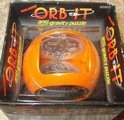 Orbit - Shelcore 1987 Uses a mirror similar to the Nervous Breakdown series. Others in this series (I don't have): Zapped, Double Cross, Roto Maze |
||||
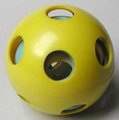 This "Ball-in-ball-in-ball" puzzle is from Hungary. Find and align the correct holes in the three nested hollow spheres so that the enclosed marble will come out. Similar nested sphere puzzles are made in China from carved jade or plastic - there is no internal marble, but the objective is to align all the holes among the nested spheres. |
 A French dexterity puzzle called L'Enervant. Get the marble into the center detent. |
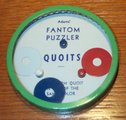 Quoits - get the three colored rings onto their corresponding posts. Will a magnet help? |
||||
|
||||||
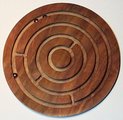 An unnamed wooden pigs-in-clover style puzzle. |
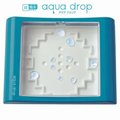
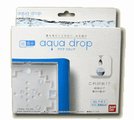
Aqua Drop - Bandai The inside surface seems to be made from a hydrophobic plastic - the bead of water runs around like mercury! |
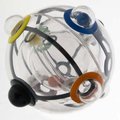
Rubik's 360 A gift from Brett. Thanks! |
||||
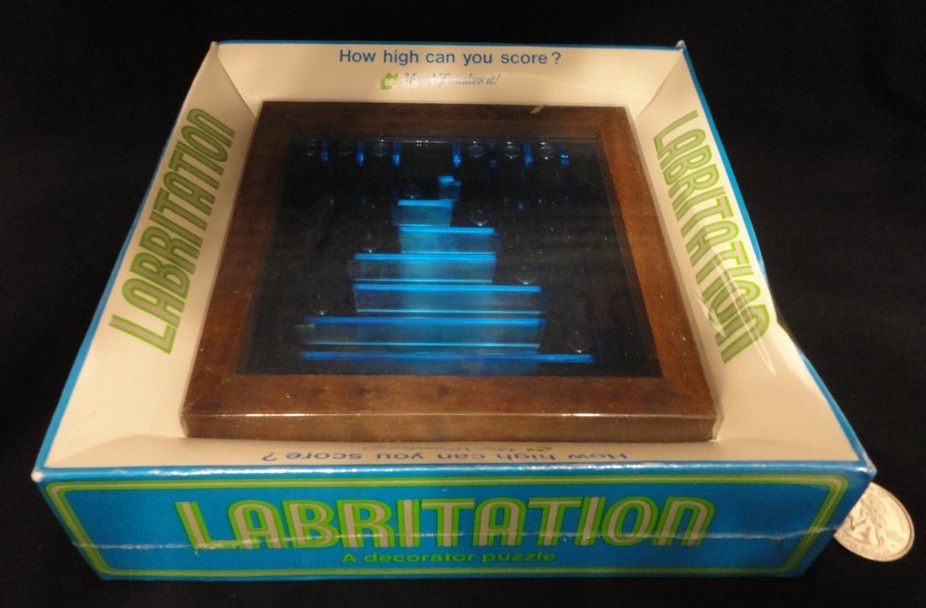
Labritation - by Mag-Nif 1975 A vintage dexterity puzzle - guide the ball through the maze without dropping into a pitfall. |
||||||

1964 Tilt-n-Roll dexterity puzzle by Milton Bradley Move a ball along a track that spans both sides of each end, avoiding the holes along the way. (It's big - that's a U.S. Quarter coin.) |
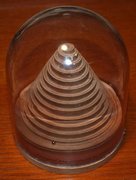
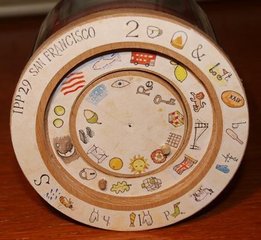
Roll Up! Roll Up! - designed by Simon Bexfield Exchanged by Simon at IPP29 in San Francisco I purchased this copy from Jeff Aurand for the Australian Flood Relief Auction Seems like a well-made version of the "Pick-Me-Up" or "Upsy-Downsy" spiral ramp design, but if you manage to get the ball up the ramp, you'll discover another challenge beyond your coordination. The bottom of the puzzle depicts a Rebus and two rotating dials. Hmmmm. |
|||||
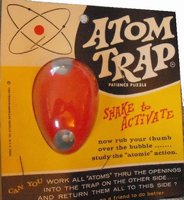
The Atom Trap - a vintage 1969 dexterity puzzle from the Franco-American Novelty Company of NYC. The transparent hollow egg contains a divider panel having two holes, and is filled with a bunch of styrofoam beads. The objective is to move the beads all to one side of the panel or the other - but the beads acquire a static charge when the egg is shaken, and hilarity ensues as they fail to cooperate. |
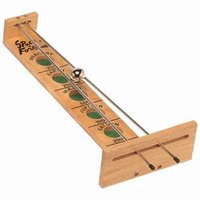
Shoot the Moon - a classic dexterity game/puzzle. Place the large ball bearing at the far end of the pair of rods. Carefully move the rods apart to get the ball to roll "uphill" towards you. Drop the ball in as close a hole as possible for the highest score. |
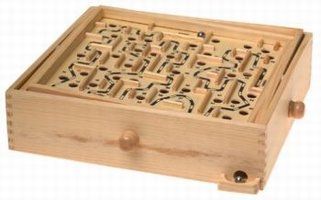
A classic Labyrinth dexterity game/puzzle. Place the ball bearing in the maze at the start position. Using two knobs that control the tilt of the surface along the X and Y axes, navigate the ball as far as possible towards the end and avoid all intermediate holes. |
||||
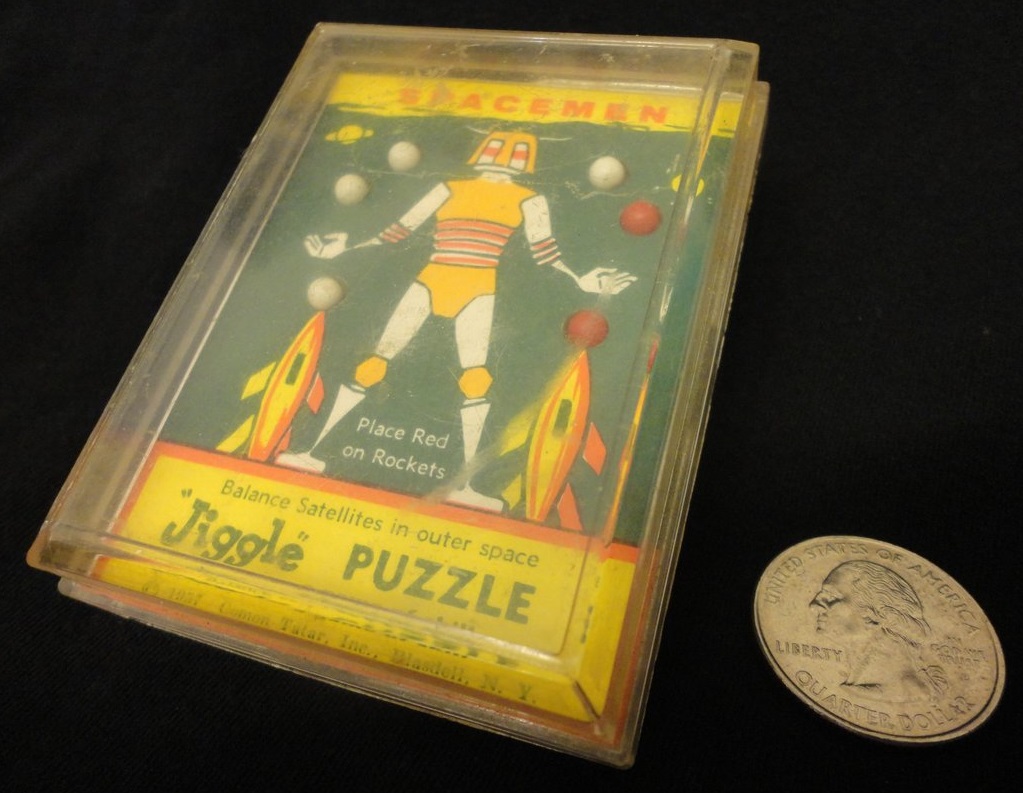
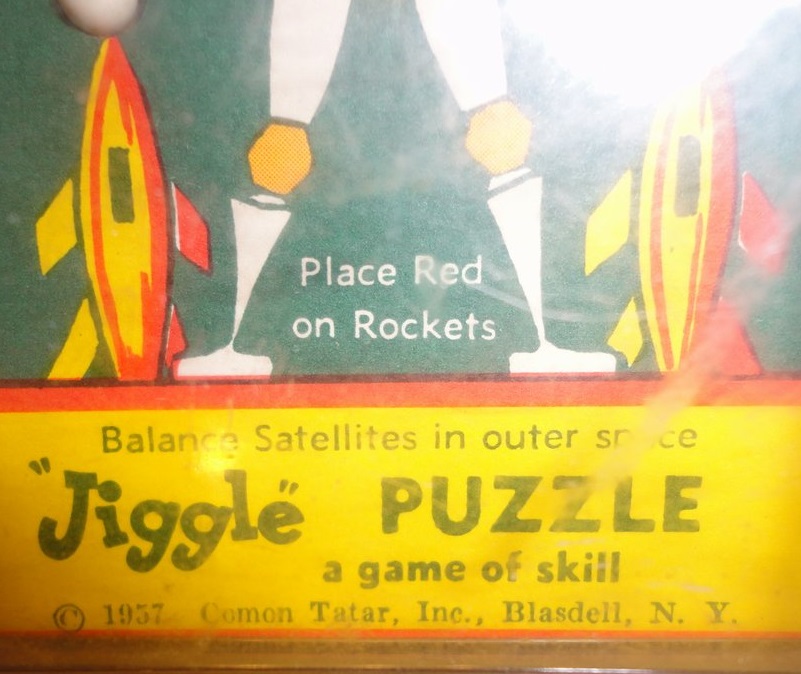
Spacemen Jiggle Puzzle issued by Comon Tatar 1957. One of a series of several puzzles in this style issued by Comon Tatar. |
||||||
Loncraine Broxton (part of the Lagoon Group) offers a series of "The Ultimate Crazy Maze" rolling ball dexterity puzzles. They are very difficult.
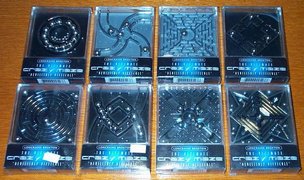
Here is the original series of 1 through 6, plus recent additions 7 and 8 (which supposedly replace 2 and 6). |
The individual puzzles don't have names as far as I know - here they are shown in order left to right, top to bottom:
|
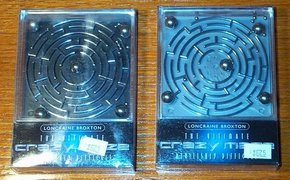
The puzzles came with black or gray plastic backgrounds - examples shown here. |
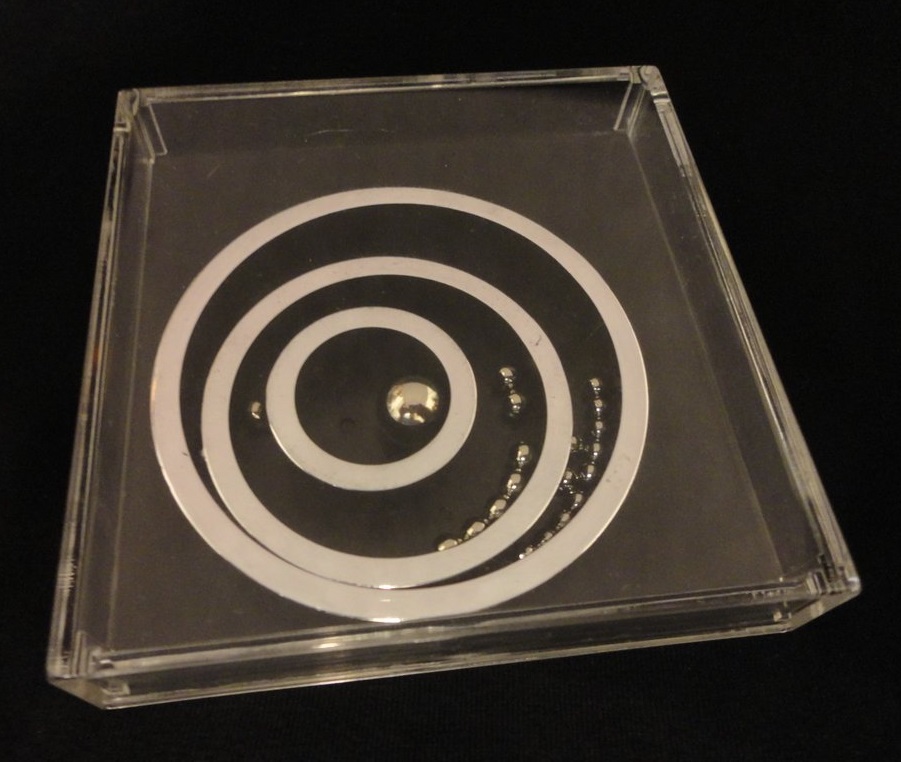
A gift from fellow collector Colin James, who says this is an alternative form of No. 4. |
||





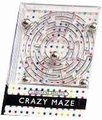 The original set was also re-issued with colorful backgrounds.
The original set was also re-issued with colorful backgrounds.
(I don't have these.) |
||
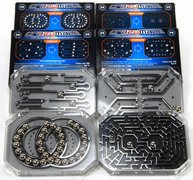
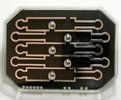
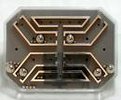
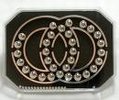
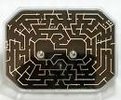
Four larger puzzles have been issued: Circuit, Invader, Cyclops, and Multi-Maze. (I only have Cyclops and Multi-Maze.) 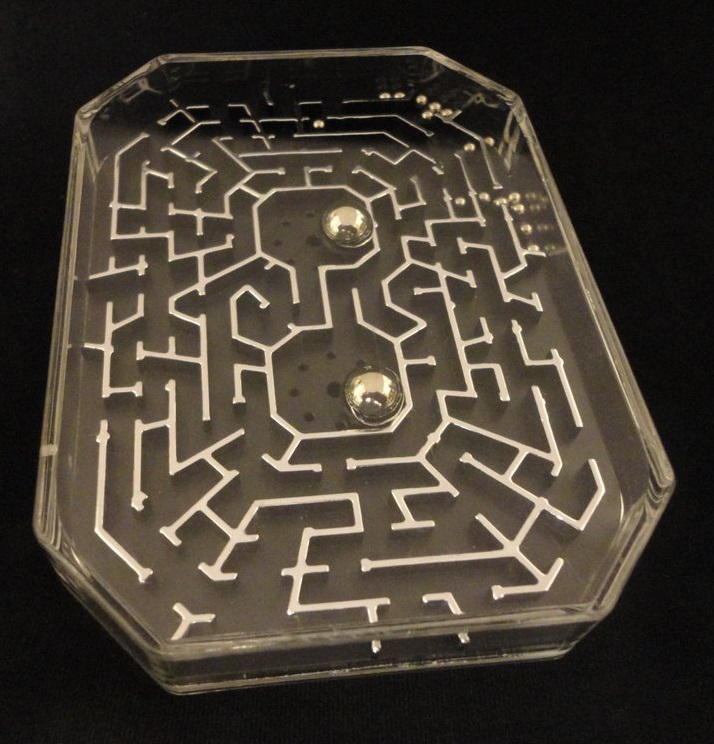
|
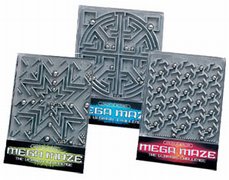
Three "Mega-Maze" puzzles have been issued. (I have Mega-Maze Titan.) 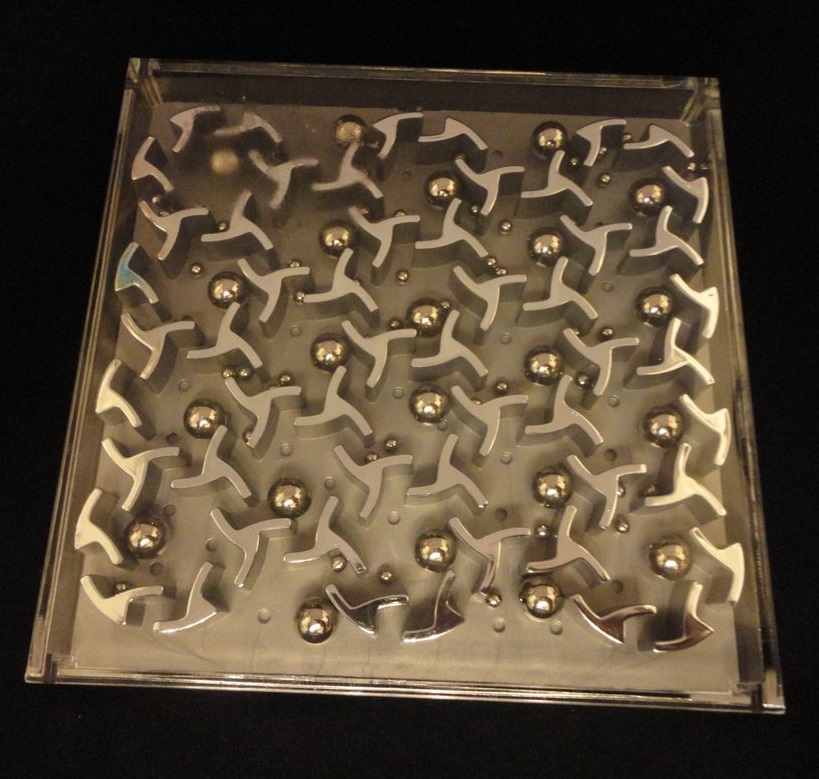
|
|
As with many dexterity puzzles, in the series of Nervous Breakdown puzzles (Kohner 1968), you must tilt steel balls into various receptacles. The twist here is that the playing field is upside down, flat across the top of the puzzle box, and you are looking at it via a mirror that makes it appear vertical against the back. The arrangement is kind of like a periscope. The top of the box is translucent so the field is well lit from "behind." The view through the mirror makes the balls seem weightless, and it is difficult to get used to how to tilt the puzzle to make the balls go where you need them to go!
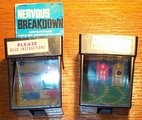
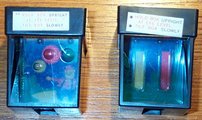


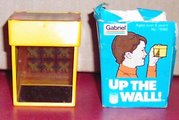


|
|
Here are shots of the backgrounds:









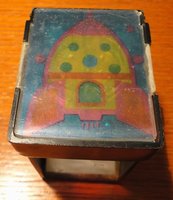
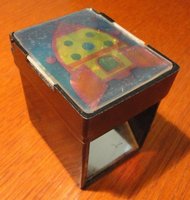
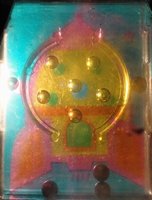 I found what I believe to be another member of the series.
I found what I believe to be another member of the series.
This version features a rocket background, but the case is more narrow than the others in the series. |
Also, based on the photo below (of items I do not own), the Nervous Breakdown puzzles had been distributed as
"cartridges" along with a single mirrored base unit.
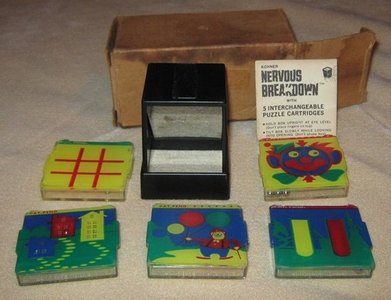
|
In the 1970's, Reiss Games Inc. (a subsidiary of National Paragon Corp.) offered several dexterity puzzles in their Shock Absorbers, Hand Shakers, and Nerve Wrackers series. These are probably my favorite dexterity puzzles - I enjoyed them as a kid, and most of them are actually possible to solve without too much difficulty.
The Romany Merchandise Corp. seems to have issued duplicates of the Shock Absorbers line, but under different names.
The Shock Absorbers are "a squad of racy little puzzles to rally with."
They include:
|
Each of the Nerve Wrackers is "A zany little puzzle that will unnerve you."
They include:
|
Each of the Toughies is "A tough little trick to figure out."
"We're a group of little tricks just waiting to be figured out. Play with me and I promise you a good time."
(It seems to me as though they tried, via the names and slogans, to incorporate some innuendo into the marketing pitch.)
They include:
|

 Idle 1974 No. 301-200 also alt. version not solved |


 Hubcap 1977 No. 302 |
 Hubcap - alternate version 1974 No. 302-200 solved! |

 Points 1974 No. 303-200 |

 4Barrel 1977 No. 304 |

 4Barrel - alternate version |

 Clutch 1974 No. 305-200 |
 U Joint - #306 |
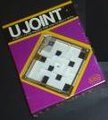 U Joint alt. version #306 not solved - tough! |
 U Joint also appeared as "Candy" Style #3306 Copyright 1974 by the Romany Merchanidise Corp. |
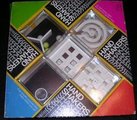 Hand Shakers set includes: Idle, Hubcap, Points, Clutch, and the alt. U-Joint (I don't have this.) |
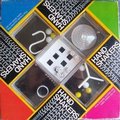 alt. Hand Shakers set includes: Idle, Hubcap (alt. version), Points, Clutch, and U-Joint. |


 Fidget 1976 No. 391 |
 Jumpy 1976 #392 not solved |


 Antsy 1976 No. 393 solved! |

 Jitter No. 394 |

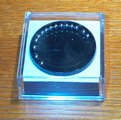 Queasy No. 395 Achieve the state shown - all balls around the perimeter. solved! |



Quiver 1976 No. 396 solved! |

 1976 No. 371 |
 1976 No. 372 |
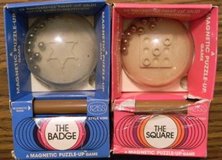
The Badge and The Square
Two Magnetic Puzzle Up Games, dexterity challenges copyright 1979 by Reiss Games Inc.
Each comes with a magnetic wand, to be used to correctly stack the steel balls inside the plastic domes.
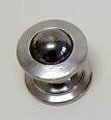
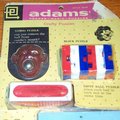
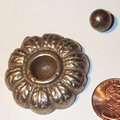
Using only the fingers of one hand, pick the ball out of the cup. My kids have no trouble, but adults are often stumped. There is a "trick" solution involving an unusual way of gripping the ball. The vintage set from Adams includes a similar puzzle called the "Sambo Puzzle" - remove the ball from Sambo's mouth. Also included is a classic called the "Dipsy Ball Puzzle" - get one ball into each end of the cradle. The flower-shaped version is "Pick It Out" from a vintage tangle set. |
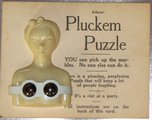
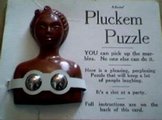
This is a racier version of the same idea - pluck the two balls from their sockets. Two versions, white and black plastic. I bought the white one from the grandson of the founder of the Adams Company. |
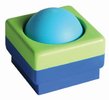 Lift Off - Thinkfun A modern version of the same concept - or is it? |
I use this subclass to group puzzles which call for great care to be employed to either construct a pile, or to deconstruct a pile, without disturbing the bulk of the pile in the process.
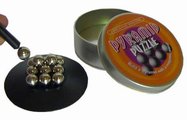
This is the Pyramid Puzzle by Loncraine Broxton. You are to build a pyramid having a 3x3 base with the 14 steel ball bearings, using a magnetic wand that allows you to pick up and release them. A base with a 3x3 grid of very shallow detents is provided. Twitch even a micrometer, and hilarity ensues :-) |

I've had this Parker Brothers Jack Straws game since I was a kid. A nice version of the classic "Pick Up Sticks," with detailed small models of various implements such as a sword, ladder, crutch, and saw. Dump the pieces in a pile, then try to remove the pieces one by one without disturbing the rest of the pile. Can be played alone or in competition. A true test of dexterity as well as one's powers of inspection. |
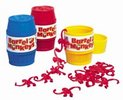
The Barrel of Monkeys is a classic dexterity feat which is usually played as a competetive game among youngsters. See U.S. Patent 3414265 - Marks 1968 |
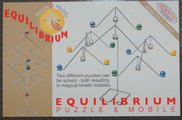
Equilibrium - construct the free-standing mobile sculpture, balancing the marbles. A gift from Brett. |
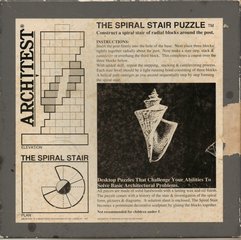
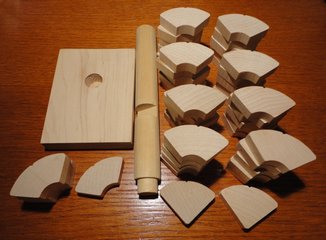
The Architest Spiral Stair puzzle requires you to build a spiral staircase around a central spindle, cantilevering the quarter-circle shaped steps. It was issued in 1987 by architect Tim Leefeldt. |
|
This section covers vintage dexterity puzzles by R. Journet.
 Neil Adams, of Cornwall, England,
is a collector of Journet puzzles.
I purchased from Neil a copy of a poster he made showing the Journet puzzles in his collection.
Neil told me he is unaware of any
published definitive lists or books about
the Journet line.
However, in January of 2006 an original pre-war trade catalogue
auctioned
for $1136.
I did not win that, but
I was able to acquire a pamphlet by James Dalgety entitled
"R. Journet & Company, A Brief History of the Company & its Puzzles."
Neil provided me some history:
"Robert Journet started
a toy shop in 1878 in Paddington.
His father hand-made the first puzzles circa 1891.
The business did not really get going until 1918 when they attended a British Industries fair
and many sales were made to the U.S.A.
Robert died in the 1930's and his son Frederick took over the business and
expanded it, picking up many advertising orders, and kept it going until he
sold it in 1965 to Abbey Corinthian Games who produced puzzles from 1966 until some time in the 1970's."
Neil Adams, of Cornwall, England,
is a collector of Journet puzzles.
I purchased from Neil a copy of a poster he made showing the Journet puzzles in his collection.
Neil told me he is unaware of any
published definitive lists or books about
the Journet line.
However, in January of 2006 an original pre-war trade catalogue
auctioned
for $1136.
I did not win that, but
I was able to acquire a pamphlet by James Dalgety entitled
"R. Journet & Company, A Brief History of the Company & its Puzzles."
Neil provided me some history:
"Robert Journet started
a toy shop in 1878 in Paddington.
His father hand-made the first puzzles circa 1891.
The business did not really get going until 1918 when they attended a British Industries fair
and many sales were made to the U.S.A.
Robert died in the 1930's and his son Frederick took over the business and
expanded it, picking up many advertising orders, and kept it going until he
sold it in 1965 to Abbey Corinthian Games who produced puzzles from 1966 until some time in the 1970's."
Frank Potts has an extensive Journet collection, shown online.
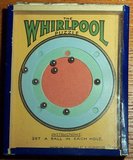 No. 102 Whirlpool |
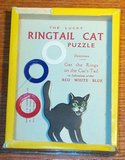 No. 68 Ringtail Cat |
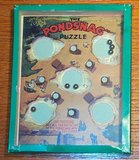 No. 97 Pondsnag |
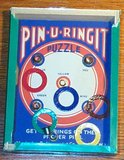 No. 64 Pin-U-Ringit |
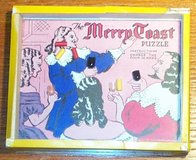 (No #) The Merry Toast |
 No. 84 Pigs in Clover |
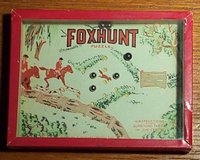 (No #) Foxhunt |
|
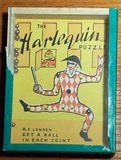 (No #) Harlequin |
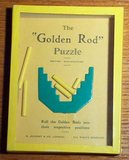 No. 67 Golden Rod |
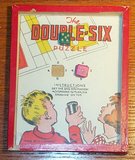 (No #) Double Six |
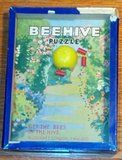 No. 75 Beehive |
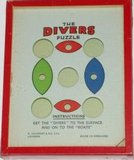 No. 92 Divers |
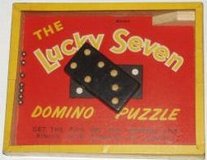 (No #) Lucky Seven |
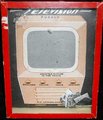 (No #) Television |
|
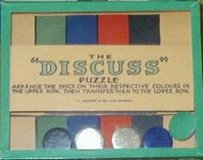 No. 91 Discuss |
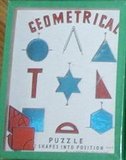 (No #) Geometrical |
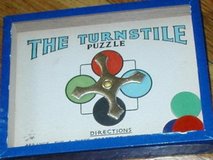 No. 94 Turnstile |
|
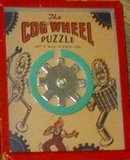 No. 109 Cog Wheel |
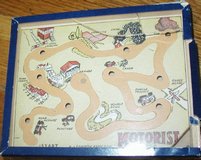 No. 104 Motorist |
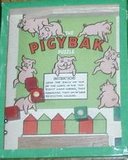 No. 114 Pigybak |
|
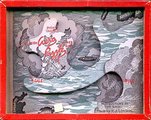 No. 79 Aero |
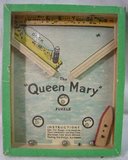 No. 108 Queen Mary |
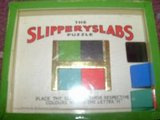 No. 95 Slippery Slabs |
|
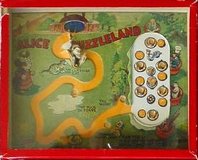
No. 98 Alice in Puzzleland |
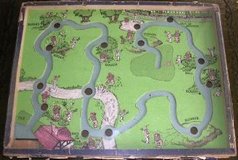
(No #) Golf |
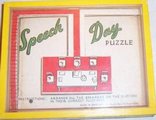
No. 101 Speech Day |
|

No. 57 Dovecote |
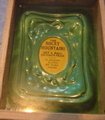
No. 76 Rocky Mountains |
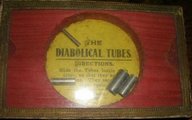 No. 61 Diabolical Tubes |
|
 No. 69 Balansit |
 No. 70 Kanuduit |
 No. 50 Bowling Green |
 No. 99 Four Cones |
 No. 66 Niagara |
 No. 80 Rabbits in Corn |
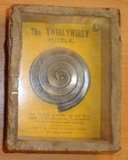 No. 56 Twirlywirly |
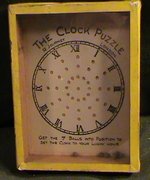 No. 63 Clock |
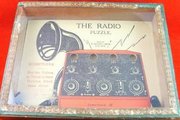 No. 72 Radio (wide version) |
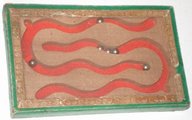 No. 60 Wiggle Woggle |
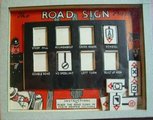 No. 112 Road Sign |
|
 No. 58 Bagatelle |
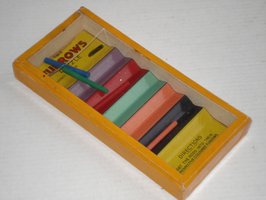 No. 88 Furrows |
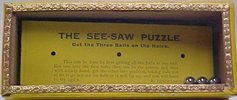 No. 51 See-Saw |
|
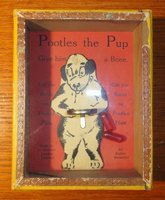
No. 73 Pootles the Pup |
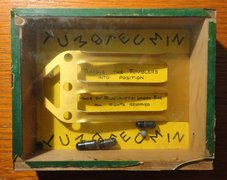
No. 74 Tumbleumin |
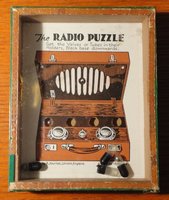
No. 72 Radio (tall version) |
|

No. 86 The Brooch I was pleased to find this, being one of the rarer ones, in good shape.
|
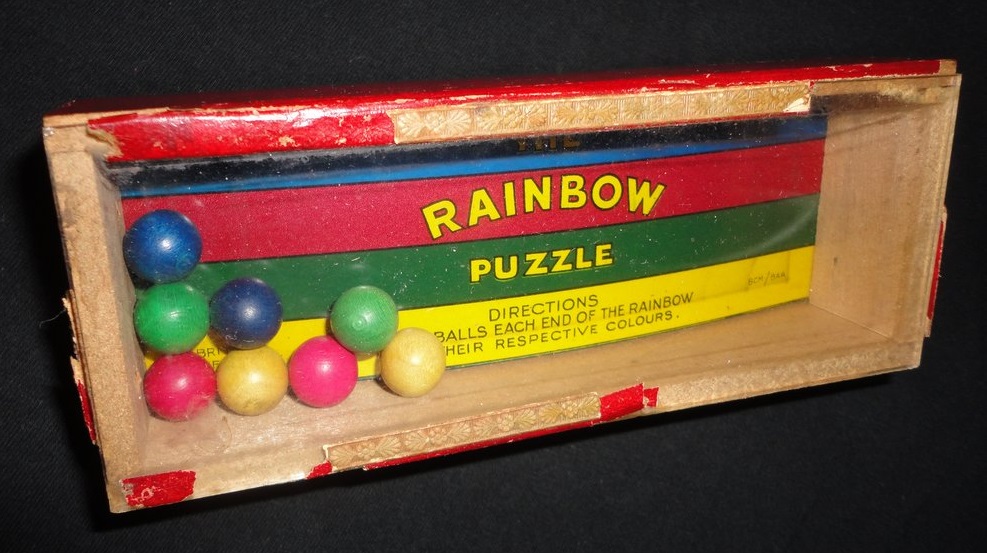
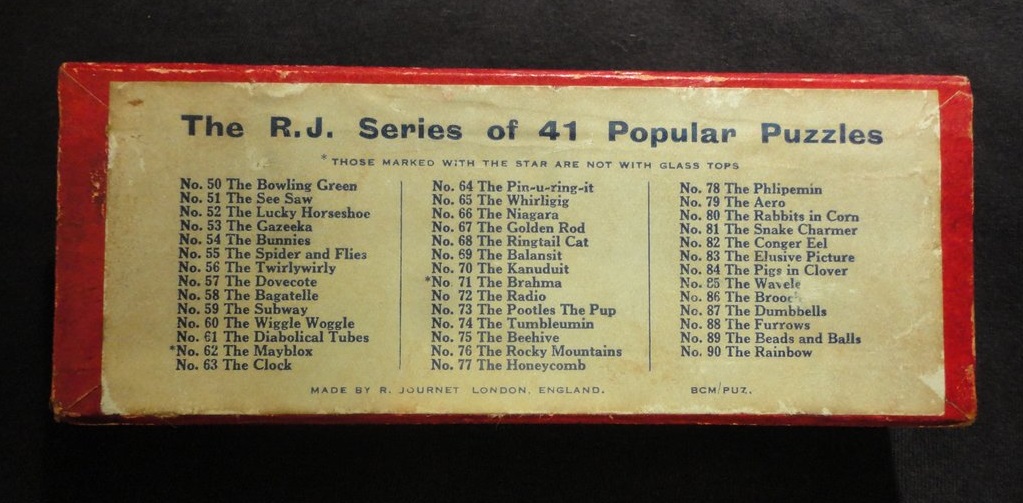
No. 90 The Rainbow Puzzle |
||
This section is intended to serve as a "checklist" for Journet collectors. Coming up with this while having limited access to documentation on the Journet line was a challenging but enjoyable exercise in detective work. The puzzles used to have a list on their backs assigning name and number (starting at 50) to the various puzzles in the Journet lineup, but this was replaced with an alliterative advertising slogan. I compiled this based on information from Neil, from the poster Neil issued, and from various pictures of the backs of Journet puzzles which had lists rather than the slogan - many of which were frustratingly difficult to read. In the end I was able to check the list against a pamphlet I acquired by James Dalgety entitled "R. Journet & Company, A Brief History of the Company & its Puzzles" and cleared up the last of the question marks I had. The results of my sleuthing turned out pretty accurate!
Different color versions of many of the puzzles are available, as well as variants with different numbers of balls and even mercury instead of balls. I have no idea how many different variations of each puzzle Journet made, but here are pictures of almost all the different basic puzzles, followed by the checklist.
(I collected the photos from various places on the web and while the layout here does not permit me to properly attribute each one, I am certainly grateful to the owners of the images.)


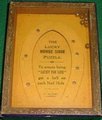

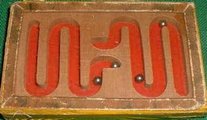
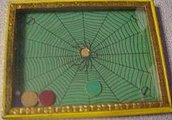




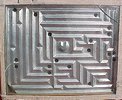


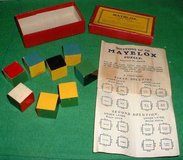
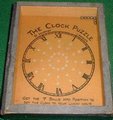








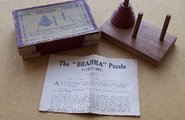




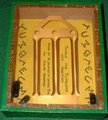




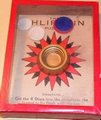

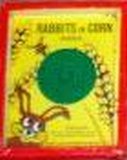

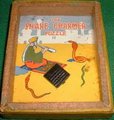
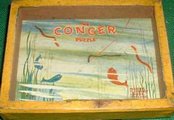
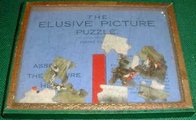
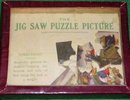


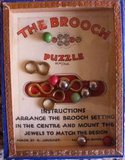


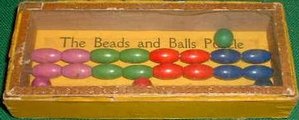
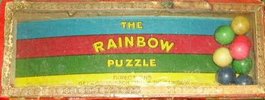


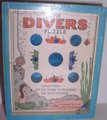
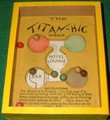





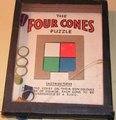
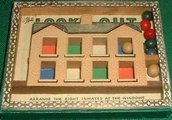


![]()
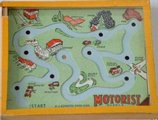

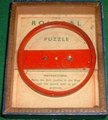
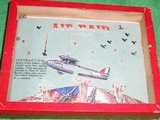


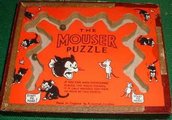
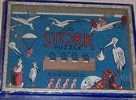
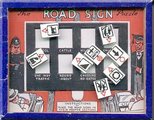
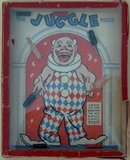



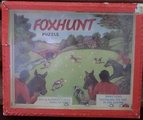









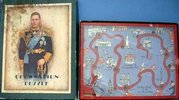
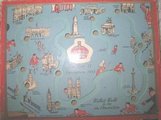
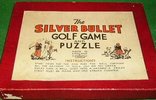
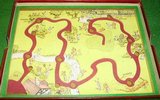
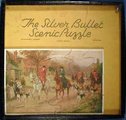
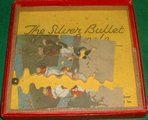
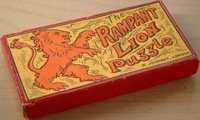
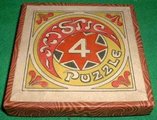
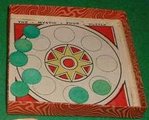
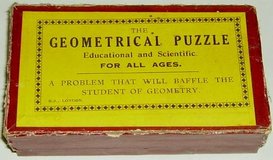

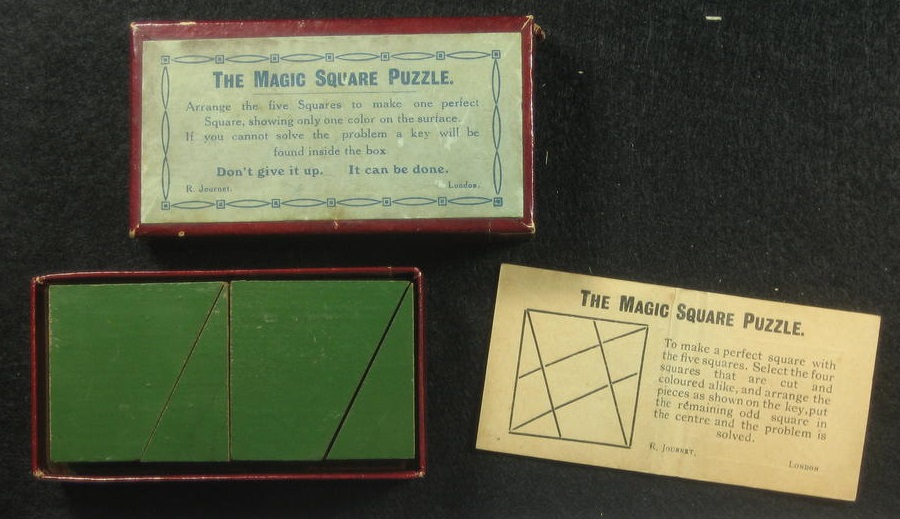
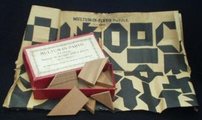
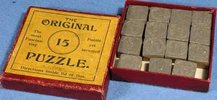
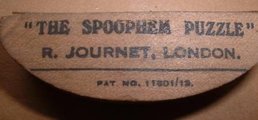
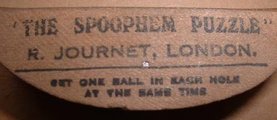
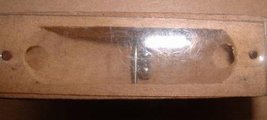
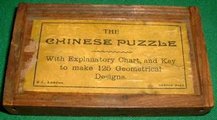
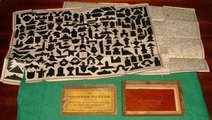
|
|
|
|
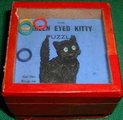
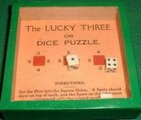
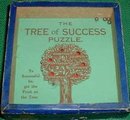

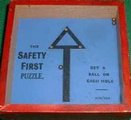
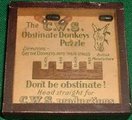
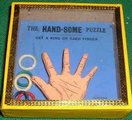
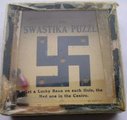
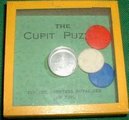
|
|
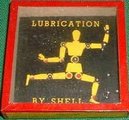
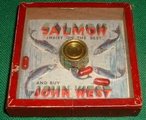
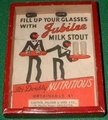
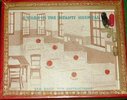
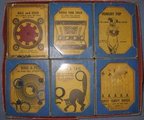 The designs in this set of six boxes put out by Gilbert are very similar to Journet designs, and include a Cogwheel, a Radio, a begging Pup, and a Cat. |
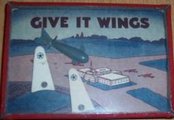 Give It Wings - jiggle until you've attached the wings to the fuselage. |
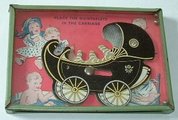 Get the Dionne Quintuplets in the carriage. |
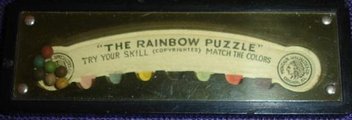
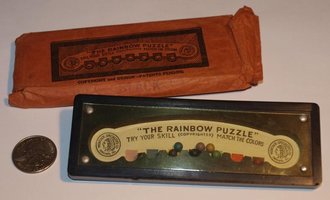
"The Rainbow Puzzle" - a vintage dexterity challenge by Montauk Specialties Co. of Chicago Ill., also found one with its original package. It's similar to "Jumpy" by Reiss. |
||
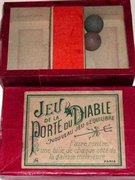 A vintage French boxed puzzle, Porte du Diable. |
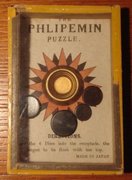 Japanese copy of Phlipemin |
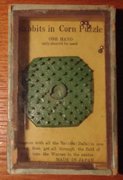 Japanese copy of Rabbits in Corn |
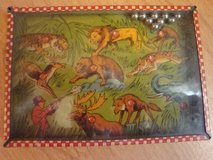
Another vintage dexterity puzzle, the Jungle Puzzle |
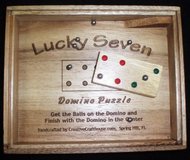
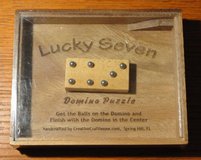
Lucky Seven (I solved it!) from Puzzle Crafthouse (Thanks, Dave!): |
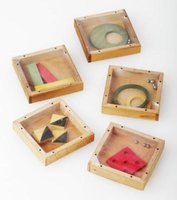
A set of small vintage wooden deterity puzzles, made in Japan |
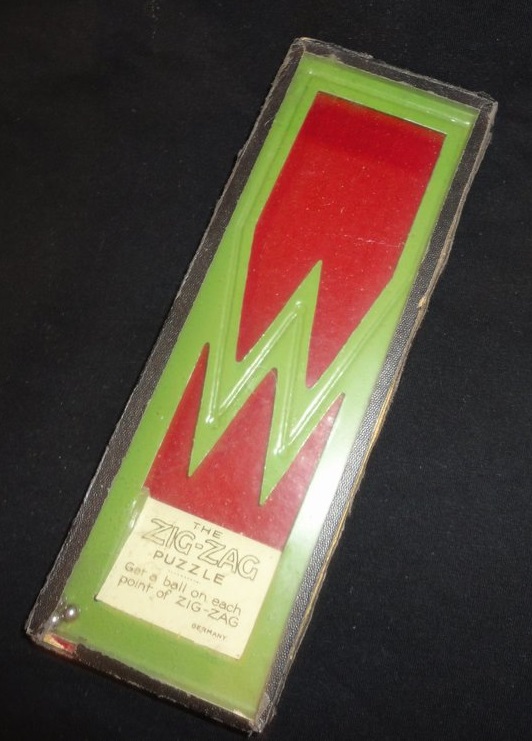
Zig Zag - a vintage dexterity puzzle. |
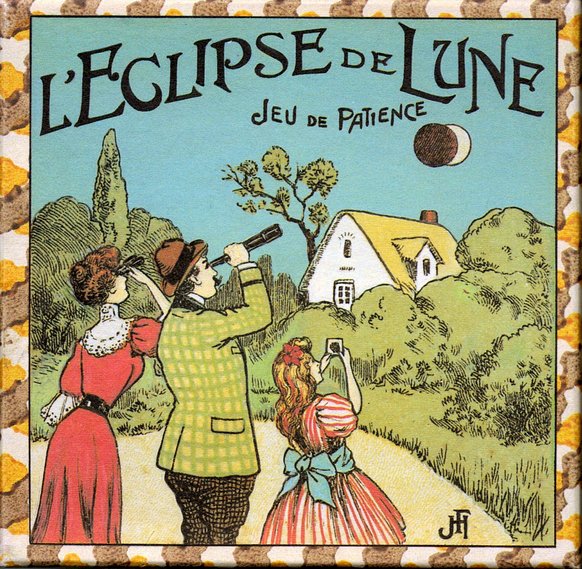
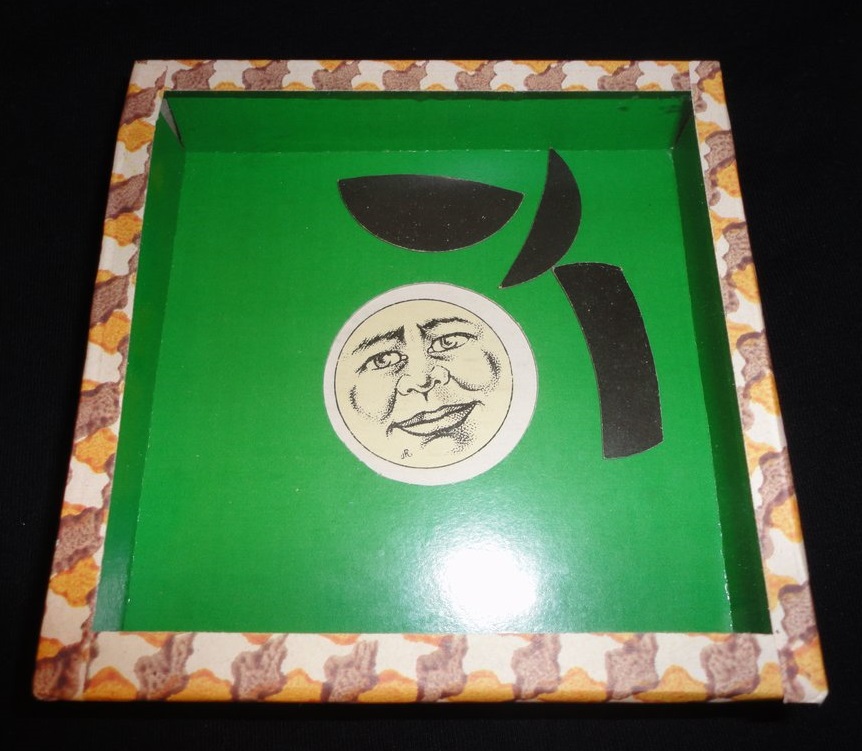
L'Eclipse de Lune - repro of a vintage French Boxed dexterity puzzle, copyright 1984 by Franz-Josef Holler, Munich. Shake the three black pieces to cover the face of the Moon. I like this one since it is not too difficult. |
|
|
Melissa & Doug
have issued a series of colorful dexterity puzzle boxes they call "Pocket Mazes."
I have some, in bold.
Will they one day be as sought-after as the Journets?
|
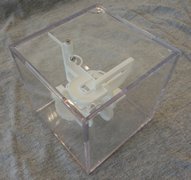 IPP32 Mini-Perplexus, designed by Michael McGinnis, made by Shapeways, exchanged by Tanya Thompson at IPP32 Michael is one of the inventors of Perplexus, nee Superplexus. |
There are several dexterity puzzles in bottles or in glass tubes.
 Wil's Magic Bottle (Ishi) |
Eureka Bottle #1 |
 Eureka Bottle #2 |
Eureka Bottle #3 Combines dexterity with a hidden-mechanism piece. |
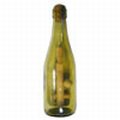 Jacob's Revenge |
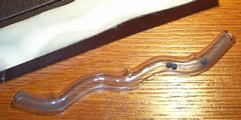 This glass tube contains 3 metal pellets (swan shot) - get one into each detent. It appears in Hoffmann on page 9, as No. XII - The Switchback. From the Steve Merritt collection. |
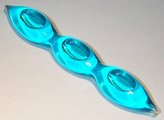 Not sure what this is called, but the object is to get a single bubble in the middle bulb. |
|
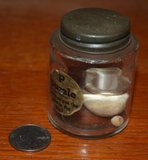
P Puzzle "Can you put the pea in the pot?" Have a look at U.S. Patent 775695 - Young 1904 |
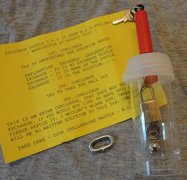 Exchange, designed, made, and exchanged at IPP32 by Wil Strijbos |
||